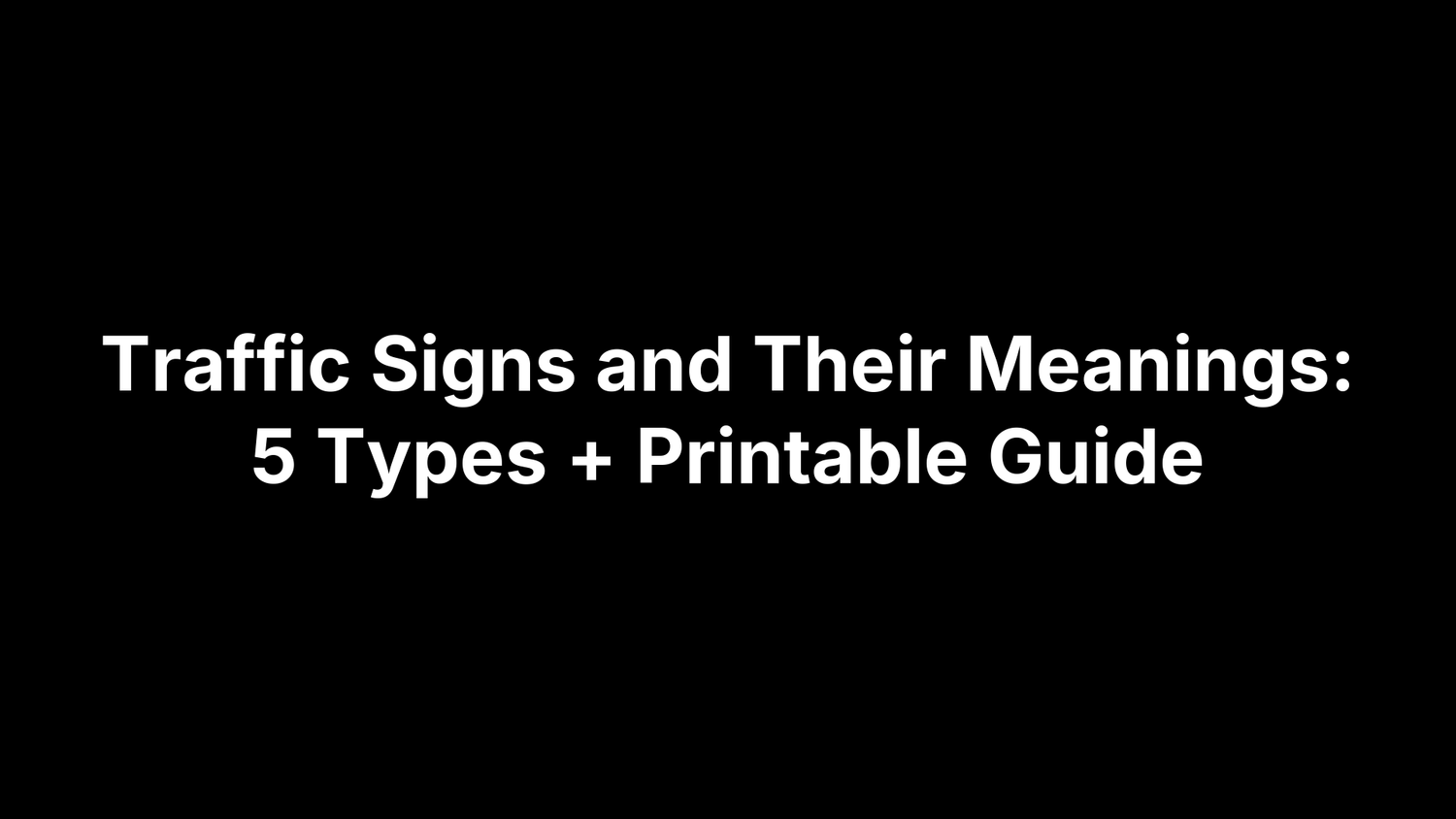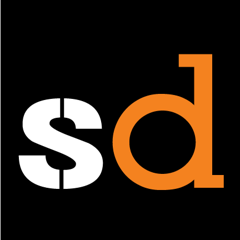Traffic Signs and Their Meanings: 5 Types + Printable Guide
Studying for your permit test—or just trying to be a sharper driver—can hit a snag when the signs start to blur together. Was that diamond yellow or orange? Do red, white, and blue always mean the same thing? The quickest way to master road signs is to recognize patterns: color, shape, and a few must-know symbols. If you can spot the type at a glance and recall what to do, you’ll answer test questions faster and react sooner on the road. And that’s exactly what exam questions probe: recognition plus the correct action.
In this guide, you’ll get a clean breakdown of the five U.S. traffic sign types you need for the DMV test—regulatory, warning, guide, service and recreation, and temporary traffic control—organized by color and shape, with clear examples, what to do when you see each sign, and quick DMV tips. We’ve also included a free printable PDF you can study offline or keep in your car. Outfitting a workplace or fleet? Safety Decals can create custom, MUTCD‑informed decals to match your environment. Let’s start with the printable and a quick color‑and‑shape decoder, then go type by type.
1. Free printable guide + custom traffic decals (Safety Decals)
Download a printer‑friendly, one‑page PDF that puts traffic signs and their meanings into a simple, study‑first layout. It mirrors MUTCD color and shape conventions so you can recognize types at a glance.
What it covers
The guide organizes the five sign types with a color/shape key, high‑frequency examples, and plain‑language “what to do” notes. It’s built for quick permit‑test review and on‑the‑job refreshers.
Colors and shapes at a glance
Spot the sign type before you read a word—exactly how DMVs teach it. Use this fast map on the printable to trigger instant recognition.
- Regulatory: red/white/black
- Warning: yellow diamond
- Temporary (work zone): orange diamond
- Guide/Service/Recreation: green/blue/brown
Common examples to know
These appear everywhere—on exams and in daily driving—so they’re perfect anchors for memory. Learn the action tied to each symbol first, then add variations.
- Stop: complete stop
- Merging Traffic: vehicles entering
- Road Work Ahead: workers/equipment
What to do
Print the PDF, tuck it into your handbook, and post a copy where trainees meet. Outfitting a site or fleet? Safety Decals can produce custom, MUTCD‑informed decals and reflective markings sized and built for your environment.
DMV test tip
Cover the words and identify signs by color and shape first; confirm with the symbol. Red means stop/yield/prohibition, yellow warns, and orange marks work zones.
2. Regulatory signs (stop, yield, speed limits)
Regulatory signs set the rules you must follow—direction of travel, right‑of‑way, speed, passing, turns, and parking. They’re enforceable: ignore them and you can be ticketed. Knowing these traffic signs and their meanings turns split‑second recognition into the correct action on the road and on the permit test.
What it covers
Speed limits, stops and yields, movement and lane control, turn and pass restrictions, one‑way and roadway closures, and pedestrian/parking regulations you’re legally required to obey.
Colors and shapes at a glance
Most regulatory signs are white with black or red legends and are usually rectangular. Red is reserved for STOP, YIELD, and prohibitions per MUTCD, so a red cue means an order.
- Red = stop/yield/prohibit
- White/black = rules to follow
- Red circle + slash = action not allowed
Common examples to know
Focus on the high‑frequency signs you’ll see on exams and every drive.
- Stop: complete stop; proceed when clear
- Yield: slow; give right‑of‑way
- Speed Limit: maximum lawful speed (unless otherwise posted)
- Do Not Enter/Wrong Way: do not proceed; turn around safely
- One Way: traffic flows only in arrow direction
- No U‑Turn/No Left Turn: movement is prohibited
- Keep Right: pass to the right of divider/obstruction
What to do
Read the rule and comply immediately—stop fully at the line, yield until the path is clear, match your speed to the posted limit, follow lane/use arrows, and never perform a movement that’s expressly prohibited.
DMV test tip
Use color first, action second: red means stop, yield, or “don’t.” White rectangles spell out rules. If you see the red slash, the pictured movement is illegal—choose “not allowed” answers.
3. Warning signs (curves, merging, crossings)
Warning signs give you advance notice of hazards or changes ahead so you can slow, scan, and choose the safest path. On the permit test, questions often pair a yellow diamond with a scenario—curves, merging traffic, lane drops, or crossings—and ask what you should do next. Master these traffic signs and their meanings to turn early notice into smooth action.
What it covers
Expect alerts for road alignment, lane configurations, intersections, surface/visibility conditions, grades, and places where people or animals may cross.
- Road shape: curves, sharp turns, winding sections
- Lane changes: lane ends, merge, two‑way traffic
- Intersections: crossroad, T/Y, roundabout, signal ahead
- Surface/conditions: bump, dip, slippery when wet, loose gravel
- Grades: hill/downgrade
- Crossings: school, pedestrian, bicycle, deer
Colors and shapes at a glance
Warning signs are typically yellow diamonds with black symbols or words, placed before the condition so you have time to respond.
- Yellow + black = caution ahead
- Diamond shape = warning category
Common examples to know
Drill the symbol and the matching action.
- Right/Left Curve: reduce speed; steer smoothly
- Sharp Turn/Double Curve/Winding Road: slow early; hold lane
- Merging Traffic: create a gap; adjust speed
- Lane Ends: merge early; don’t force your way
- Two‑Way Traffic: watch oncoming vehicles after divided highway ends
- Slippery When Wet: gentle steering/braking
- Traffic Signal Ahead: be ready to stop
- Hill/Downgrade: check speed; use lower gear if necessary
- Pedestrian/School/Bicycle Crossing: yield; expect slower users
- Deer Crossing: scan shoulders; lift off the accelerator
What to do
Ease off the throttle before the hazard, increase following distance, and commit to smooth inputs—no hard braking mid‑curve. Yield to crossing users, merge early when lanes end, and plan an escape path if conditions deteriorate.
DMV test tip
If it’s a yellow diamond, look for the “slow, prepare, watch for” answer. For merge/lane‑end questions, pick “adjust speed and create space,” not “speed up to beat traffic.”
4. Guide signs (directions, routes, exits)
Guide signs keep you oriented. They point to cities, routes, and exits, tell you distances, and show which lane you need. On highways, they appear in sequence so you can prepare early and make smooth, legal moves.
What it covers
Expect directional information to destinations, route identification, exit numbers, lane assignments for exits, and mileage so you can plan lane changes and timing confidently.
Colors and shapes at a glance
Guide signs are typically horizontal rectangles with white legends on green. Blue and brown are used for services and recreation, which we cover next.
- Green = directions/destinations
- White letters = information, not a command
Common examples to know
Recognize these quickly and you’ll never miss your turn.
- City/Distance panels: next cities and miles to go
- Exit signs/tabs: exit number, name, and “Exit Only” lane panels
- Route markers: Interstate, U.S., and state route identifiers
- Mile markers: small green posts tracking location and progress
What to do
Read ahead, choose the correct lane early, and follow route numbers and exit tabs rather than only street names.
DMV test tip
If it’s green, choose the answer about directions, routes, or distances—“Exit Only” means that lane must leave the highway.
5. Service and recreation signs (gas, hospital, parks)
These signs help you find essentials (fuel, food, lodging, hospitals, rest areas) and leisure spots (parks, campgrounds, trail sites). For the permit test, know that these are informational—recognize them fast, then plan your move without last‑second lane changes.
What it covers
Locations and directions for traveler services, plus recreational and cultural sites. They guide decisions, not behavior—unlike regulatory signs—so you use them to plan safe, timely exits and stops.
Colors and shapes at a glance
They’re easy to spot by color. Think “travel needs” and “outdoors.”
- Blue = services (white symbols/text)
- Brown = recreation/cultural interest (white symbols/text)
Common examples to know
Memorize the symbol and the facility it points to.
- Hospital (H)
- Gas, Food, Lodging
- Rest Area
- Parking
- Park/Campground/Picnic Area
What to do
Scan ahead, move to the correct lane early, and signal in time for the exit or turn. In city areas, follow supplementary arrows or distance plaques to avoid abrupt maneuvers.
DMV test tip
If the sign is blue or brown, pick the answer about services or recreational destinations—traffic signs and their meanings here are informational, not commands.
6. Temporary traffic control signs (work zones and detours)
Work zones compress decisions into seconds. These orange warnings signal lane shifts, closures, flaggers, and rough or changing surfaces so you can slow early and keep workers and drivers safe. For DMV questions, think: identify the hazard, reduce speed, create space, and be ready to stop.
What it covers
Temporary traffic control signs manage traffic during construction, maintenance, utility work, and short‑term incidents.
- Lane changes/closures
- Detours and lane shifts
- Workers/flaggers ahead
Colors and shapes at a glance
These are designed to stand out so you adjust before the hazard.
- Orange diamond = work zone warning
- Black symbols/words = specific condition
Common examples to know
Expect these high‑frequency signs on tests and roads.
- Road Work Ahead
- Flagger Ahead
- Be Prepared To Stop
- Detour/Detour Arrow
What to do
Ease off the accelerator, scan for workers/equipment, and follow directions from signs and people.
- Merge early; don’t cut in late
- Obey temporary speed limits
- Follow flagger/arrow board instructions
DMV test tip
Orange means work zone: choose answers that say “slow down, prepare to stop, merge early, and obey the flagger” (flaggers have the same authority as a regulatory sign).
Before you hit the road
You now have the color‑and‑shape decoder and the “what to do” playbook—exactly what permit tests and real driving require. Keep the printable close, quiz yourself on commutes, and practice spotting the sign type first, then naming the action. The more you build that reflex, the calmer and quicker your decisions become.
Outfitting a facility, yard, or fleet? Standardize visuals so what drivers learn on the road matches what they see at work. Our team produces durable, MUTCD‑informed decals and reflective markings sized to your environment, with customization for materials, colors, and layouts that stand up to weather and wear. Get started with Safety Decals.
- Print the guide: Keep one in your car and one at your desk.
- Drill the sequence: color → shape → symbol → action.
- Practice spacing: slow early, create gaps, and signal sooner.


